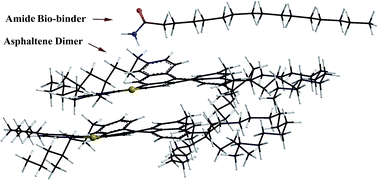Alteration of intermolecular interactions between units of asphaltene dimers exposed to an amide-enriched modifier
Abstract
Morphological features and structural characteristics of asphalt binders are strongly affected by factors such as “aging”, which can alter the performance of petroleum-based asphalt-binders. Bio-binder (BB), a newly-produced amide-enriched bio-adhesive obtained from bio-mass, has been found to be promising in reducing the negative effects that aging can have on molecular conformation. Doping of BB into a commonly used petroleum-based asphalt-binder creates a bio-modified binder (BMB) that has been proven experimentally to perform especially well at low temperatures. This improvement can be attributed to the effect of modifier fragments, which contain high concentrations of amide functional groups, on the π–π stacking of asphaltenes. In this paper, changes in the stacking behavior of asphaltene units are investigated in the presence of hexadecanamide, a representative amide-type additive. Molecular Dynamics (MD) simulations and experiments using high-resolution transmission electron microscopy (HRTEM) and X-ray powder diffraction (XRD) support our results obtained from rigorous quantum mechanical calculations through a high quantum level of DFT-D approach. Based on this multi-scale bottom-up study, interaction of the amide-type bio-binder (amide-BB) with asphaltenes disturbs the uniformity of the π density throughout the aromatic region and creates some polarization in this region. This alteration of the π system over the aromatic zone disturbs the eventual π–π interactions between asphaltene stacks that are known to be the main mechanism responsible for the formation of clusters at the nanoscale. Disturbing the π–π interactions alters the stacking distance, the corresponding binding energy, and ultimately the extent of clustering of asphaltene units. Any change in the clustering of asphaltene affects the rheology and morphological properties of asphalt, which in turn alters the asphalt's performance, including but not limited to its resistance to fatigue and low-temperature cracking.



 Please wait while we load your content...
Please wait while we load your content...